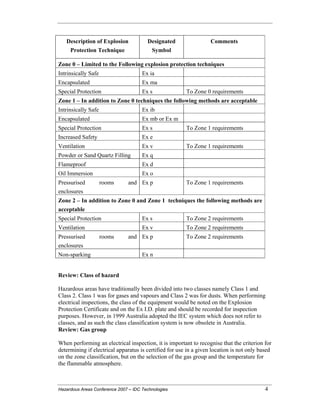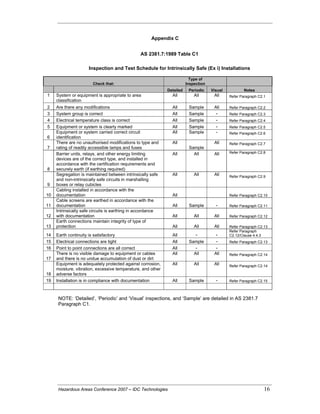Roar Solutions Fundamentals Explained
Roar Solutions Fundamentals Explained
Blog Article
The smart Trick of Roar Solutions That Nobody is Talking About
Table of Contents10 Simple Techniques For Roar SolutionsAll About Roar SolutionsWhat Does Roar Solutions Do?
In such an atmosphere a fire or explosion is feasible when three fundamental problems are met. This is commonly described as the "harmful area" or "burning" triangular. In order to secure installations from a possible surge an approach of analysing and categorizing a possibly unsafe area is needed. The objective of this is to ensure the correct selection and setup of devices to ultimately prevent a surge and to make sure security of life.
(https://pubhtml5.com/homepage/lnwzg/)
No tools should be set up where the surface area temperature level of the equipment is better than the ignition temperature of the offered threat. Below are some typical dirt harmful and their minimal ignition temperature level. Coal Dust 380C 225C Polythene 420C (thaws) Methyl Cellulose 420C 320C Starch 460C 435C Flour 490C 340C Sugar 490C 460C Grain Dust 510C 300C Phenolic Material 530C > 450C Aluminium 590C > 450C PVC 700C > 450C Residue 810C 570C The probability of the threat existing in a focus high sufficient to cause an ignition will vary from area to place.
In order to identify this danger an installment is divided right into areas of threat depending upon the quantity of time the dangerous is existing. These locations are described as Areas. For gases and vapours and dirts and fibers there are 3 zones. Area 0 Zone 20 A harmful atmosphere is extremely likely to be existing and may exist for extended periods of time (> 1000 hours annually) or also constantly Zone 1 Zone 21 An unsafe ambience is feasible but unlikely to be existing for lengthy durations of time (> 10 450 C [842 F] A category of T6 suggests the minimal ignition temperature is > 85 C [185 F] Hazardous location electrical tools perhaps developed for use in greater ambient temperature levels. This would certainly indicated on the score plate e.g. EExe II C T3 Ta + 60C( This indicates at 60C ambient T3 will certainly not be surpassed) T1 T1, T2, T3, T4, T5, T6 T2 T2, T3, T4, T5, T6 T3 T3, T4, T5, T6 T4 T4, T5, T6 T5 T5, T6 T6 T6 A T Class rating of T1 suggests the optimum surface temperature level produced by the tool at 40 C is 450 C. Assuming the connected T Class and Temperature level ranking for the devices are ideal for the location, you can always make use of an instrument with a much more stringent Division score than required for the area. There isn't a clear response to this inquiry however. It really does depend upon the sort of tools and what fixings require to be performed. Equipment with particular examination treatments that can not be carried out in the area in order to achieve/maintain 3rd party score. Have to come back to the manufacturing facility if it is prior to the equipment's service. Field Repair Work By Authorised Worker: Challenging screening might not be called for nonetheless details treatments may need to be complied with in order for the equipment to keep its 3rd party rating. Authorised workers should be utilized to do the work properly Fixing should be a like for like replacement. New element have to be considered as a straight replacement calling for no special screening of the tools after the repair is complete. Each tool with a dangerous rating need to be reviewed separately. These are laid out at a high level listed below, however for even more comprehensive info, please refer straight to the guidelines.
The 25-Second Trick For Roar Solutions
The devices register is a comprehensive data source of devices records that consists of a minimum set of fields to recognize each item's location, technological criteria, Ex-spouse classification, age, and ecological information. The ratio of Detailed to Shut examinations will be determined by the Tools Danger, which is assessed based on ignition danger (the chance of a source of ignition versus the possibility of a flammable atmosphere )and the dangerous area classification
( Zone 0, 1, or 2). Applying a durable Risk-Based Inspection( RBI )method is essential for ensuring compliance and safety and security in handling Electric Tools in Hazardous Locations( EEHA).
The Greatest Guide To Roar Solutions

In regards to explosive risk, a dangerous location is a setting in which an eruptive atmosphere is present (or might read the full info here be expected to be existing) in quantities that require unique precautions for the building and construction, installation and usage of equipment. eeha training. In this post we explore the challenges dealt with in the work environment, the threat control steps, and the called for competencies to work safely
These substances can, in particular conditions, develop explosive environments and these can have significant and heartbreaking consequences. Many of us are familiar with the fire triangle remove any kind of one of the 3 components and the fire can not happen, yet what does this mean in the context of hazardous locations?
In most instances, we can do little regarding the levels of oxygen in the air, yet we can have considerable impact on sources of ignition, for instance electrical equipment. Harmful areas are recorded on the unsafe location category illustration and are identified on-site by the triangular "EX LOVER" indicator. Below, amongst various other key info, areas are divided into three types relying on the hazard, the probability and duration that an explosive environment will certainly exist; Area 0 or 20 is deemed one of the most hazardous and Zone 2 or 22 is considered the least.
Report this page